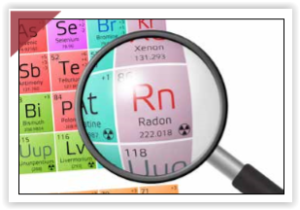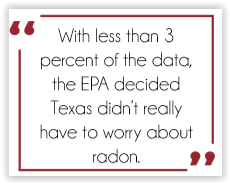Beware the False Negative
COULD THERE BE RADON IN TEXAS?
 February is Cancer Prevention Month, and I’ve been thinking about radon. Early in my career, I used to test for the gaseous chemical. The only time I found any radon was on a marble fireplace mantle that had been imported from Italy. This won’t come as a surprise to most people. If you check the Environmental Protection Agency’s (EPA) website, you’ll see a report that claims there’s little to no radon in the state of Texas. This report is based off a study done in the late 1980s, when the EPA collected samples from all 50 states to investigate the dangers of radon. A few years ago, I struck up a conversation with Dr. Quadra Stahl. He was with the Texas Department of State Health at the time, and he had a very interesting story about that EPA study.
February is Cancer Prevention Month, and I’ve been thinking about radon. Early in my career, I used to test for the gaseous chemical. The only time I found any radon was on a marble fireplace mantle that had been imported from Italy. This won’t come as a surprise to most people. If you check the Environmental Protection Agency’s (EPA) website, you’ll see a report that claims there’s little to no radon in the state of Texas. This report is based off a study done in the late 1980s, when the EPA collected samples from all 50 states to investigate the dangers of radon. A few years ago, I struck up a conversation with Dr. Quadra Stahl. He was with the Texas Department of State Health at the time, and he had a very interesting story about that EPA study.
Texas received over 1,000 samplers; they were small devices that looked like tobacco canisters. They were easy to use. You would just open the canister and expose it to air on the first floor of a home for 72 hours. Radon comes up from the ground, so if the building was built in an area with high radon, the sampler will pick it up. Dr. Stahl’s team sent the samplers to locations across Texas, requesting residents to test for radon and send the samplers back so they could be given to the EPA in Washington. After three months, only around 25 samplers had been sent back.
The EPA had only budgeted enough money to provide the samplers, send them out, and then have them sent back. Neither the state nor the 
EPA had the money to contact everyone who hadn’t sent back their samplers. The radon officer called the EPA to ask what they should do, and the EPA told them to just send back what they had and call it good. With less than 3 percent of the data, the EPA decided Texas didn’t really have to worry about radon.
When Dr. Stahl told me this story, all I could say was, “Wow.” I’ve been doing indoor air quality for almost 20 years, and I’ve talked to many geologists who weren’t surprised when I told them Dr. Stahl’s story. They would just nod and tell me about a big patch of radon they knew about in El Paso, Corpus Christi, Amarillo, or on the southwest side of Houston. One guy even laughed and told me about a fault that goes right through Richmond! I’ve had so many experts tell me about radon in Texas that I’m pretty convinced those 25 samplers the EPA got produced false negatives.
Let me be clear: This article isn’t some whistleblowing conspiracy-theory piece. When I heard it was Cancer Prevention Month, I started thinking about how the EPA’s incomplete study could cause people in Texas to overlook a real risk. Radon is an issue building owners and property managers should consider — but within reason. Your building probably isn’t sitting on a radon fault. But if you are worried about radon, don’t let your concerns be dismissed by the EPA’s false negative. I no longer test for radon, but you can still reach out to geologists and have them test the soil. Since no one’s worried about radon in Texas, we probably won’t be seeing a more complete study from the EPA anytime soon.

